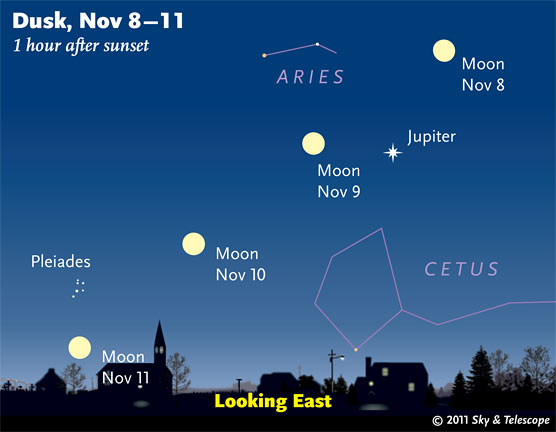
The bright Moon marches past bright Jupiter night by night. This view is for when twilight is still fading.
Sky & Telescope diagram
.
Friday, Nov. 4
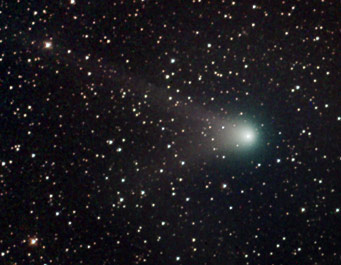
Despite first-quarter moonlight, Paolo Candy in Italy took this image of Comet Garradd (C/2009 P1) on the evening of November 4th. He used an 8-inch scope at f/3.7 and an SBIG ST-8XE
L camera for several exposures, stacked, totaling 20 minutes.
Paolo Candy
Saturday, Nov. 5
Sunday, Nov. 6
Monday, Nov. 7
Tuesday, Nov. 8
Wednesday, Nov. 9
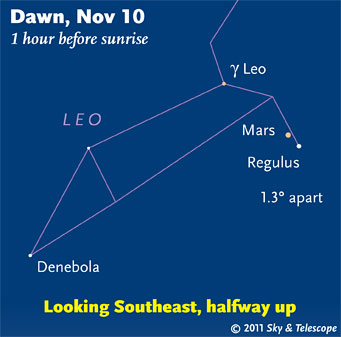
Yellow-orange Mars is passing blue-white Regulus during early morning.
Sky & Telescope diagram
Thursday, Nov. 10
Friday, Nov. 11
Saturday, Nov. 12
Want to become a better amateur astronomer? Learn your way around the constellations. They're the key to locating everything fainter and deeper to hunt with binoculars or a telescope.
For an easy-to-use constellation guide covering the whole evening sky, use the big monthly map in the center of each issue of Sky & Telescope, the essential magazine of astronomy. Or download our free Getting Started in Astronomy booklet (which only has bimonthly maps).

The Pocket Sky Atlas plots 30,796 stars to magnitude 7.6 — which may sound like a lot, but that's less than one star in an entire telescopic field of view, on average. By comparison, Sky Atlas 2000.0 plots 81,312 stars to magnitude 8.5, typically one or two stars per telescopic field. Both atlases include many hundreds of deep-sky targets — galaxies, star clusters, and nebulae — to hunt among the stars.
Sky & Telescope
Once you get a telescope, to put it to good use you must have a detailed, large-scale sky atlas (set of charts). The standards are the little Pocket Sky Atlas, which shows stars to magnitude 7.6; the larger and deeper Sky Atlas 2000.0 (stars to magnitude 8.5); and the even larger Uranometria 2000.0 (stars to magnitude 9.75). And read how to use sky charts effectively.
You'll also want a good deep-sky guidebook, such as Sue French's new Deep-Sky Wonders collection (which includes its own charts), Sky Atlas 2000.0 Companion by Strong and Sinnott, the bigger Night Sky Observer's Guide by Kepple and Sanner, or the classic if dated Burnham's Celestial Handbook.
Can a computerized telescope replace charts? I don't think so — not for beginners, anyway, and especially not on mounts that are less than top-quality mechanically. As Terence Dickinson and Alan Dyer say in their Backyard Astronomer's Guide, "A full appreciation of the universe cannot come without developing the skills to find things in the sky and understanding how the sky works. This knowledge comes only by spending time under the stars with star maps in hand."
This Week's Planet Roundup
The Sun is displaying a huge spot group past the Sun's central meridian as of November 10th. The spot group is visible with no magnification, just eyeballing it through a safe solar filter (or if haze and reddening are thick enough at sunrise or sunset; think photo opportunity!). In a filtered telescope the Sun is showing dozens of spots large and small. Hi-res image from the Solar Dynamics Observatory spacecraft.
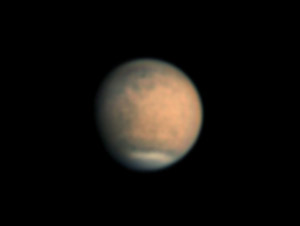
With a diameter of only 6 arcseconds, Mars still isn't much to look at in a telescope. But stacked-video imaging can work wonders. On the morning of November 2nd, Sky & Telescope's imaging editor Sean Walker assembled this shot using a 12.5-inch Newtonian reflector at f/44, a DMK 21AU618.AS video camera, and Astrodon RGB filters.
South is up; the north polar region is at bottom. The Solis Lacus area is near top, foreshortened.
Alan MacRobert
Mercury and Venus (magnitudes –0.3 and
–3.8, respectively) remain 2° apart just above the southwest horizon in bright twilight. Venus is on top; Mercury, much fainter, is below it. Early in the week look to their left to try to spot twinkly Antares, even fainter at magnitude +1.1. On November 10th all three line up in a diagonal row with Antares on the bottom — if you can see that low in bright twilight! Bring binoculars or a telescope.
Mars (magnitude +1.0, in Leo) rises around 1 a.m. daylight-saving time; midnight standard time. It's shining close to Regulus, which is nearly as bright at magnitude +1.3 and slightly blue. By the beginning of dawn they're high in the east-southeast. Mars and Regulus are 3° apart on the morning of November 5th and are within 1½° of each other from the 9th through 12th.
In a telescope Mars is a tiny blob only 6 arcseconds wide. Mars is on its way to a poor opposition next March, when it will reach a maximum width of only 13.9 arcseconds. Still, that's more than twice as big as it appears now.
Jupiter (magnitude –2.9, in southern Aries) continues blazing unusually brightly now that it's just past opposition. It's low in the east-northeast in twilight, higher in the east to southeast through the evening, and stands highest in the south by the middle of the night.
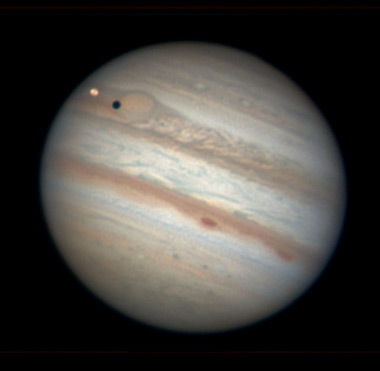
I was casting its shadow onto Jupiter's Great Red Spot when S&T's Sean Walker took this image on the evening of November 5th. South is to the upper right. The reddish South Equatorial Belt remains wider (and bicolored) compared to the North Equatorial Belt. Walker used the same imaging setup as for Mars above.
S&T: Sean Walker
Jupiter appears an unusually big 49 arcseconds wide. See our guide to observing Jupiter with a telescope.
Saturn (magnitude +0.7) is low in the east as dawn begins, a little higher every morning. Spot sparkly Spica (magnitude +1.0) 5° to its right or lower right.
Uranus (magnitude 5.8, in Pisces) and Neptune (magnitude 7.9, in Aquarius) are well placed in the south and southeast after dark. Use our printable finder chart for both, or see the September Sky & Telescope, page 53.
All descriptions that relate to your horizon — including the words up, down, right, and left — are written for the world's mid-northern latitudes. Descriptions that also depend on longitude (mainly Moon positions) are for North America. Eastern Daylight Time (EDT) equals Universal Time (also known as UT, UTC, or GMT) minus 4 hours. Eastern Standard Time (EST) is UT minus 5 hours.
NEW BOOK: Sue French's DEEP-SKY WONDERS! This big, long-awaited observing guide by Sky & Telescope's Sue French is now available from Shop at Sky. Hefty and lavishly illustrated, it contains Sue’s 100 favorite sky tours (25 per season, with finder charts) from her 11 years of writing the Celestial Sampler and Deep-Sky Wonders columns for S&T.
To be sure to get the current Sky at a Glance, bookmark this URL:
http://SkyandTelescope.com/observing/ataglance?1=1
If pictures fail to load, refresh the page. If they still fail to load, change the 1 at the end of the URL to any other character and try again.
 0
0
Comments
You must be logged in to post a comment.